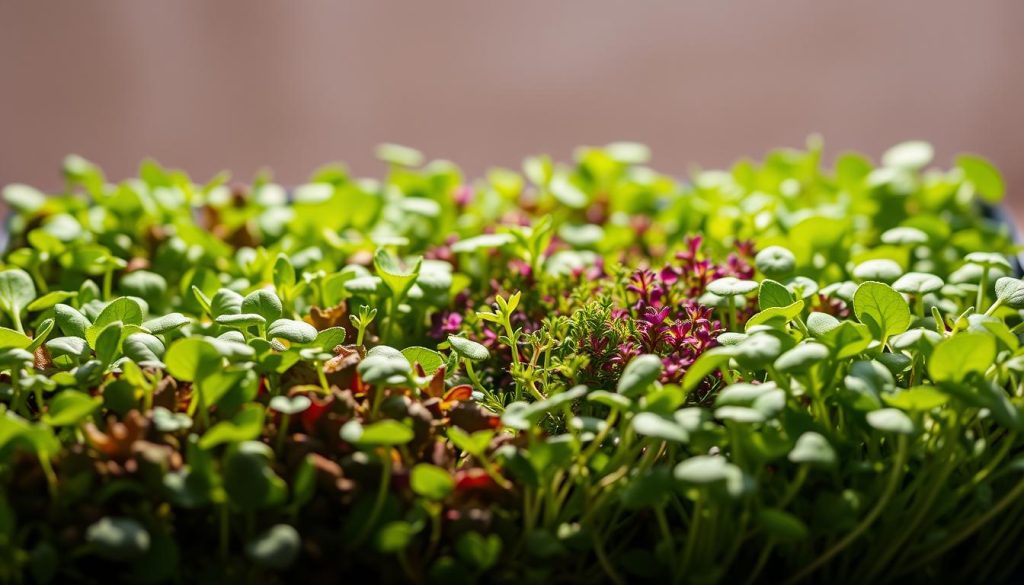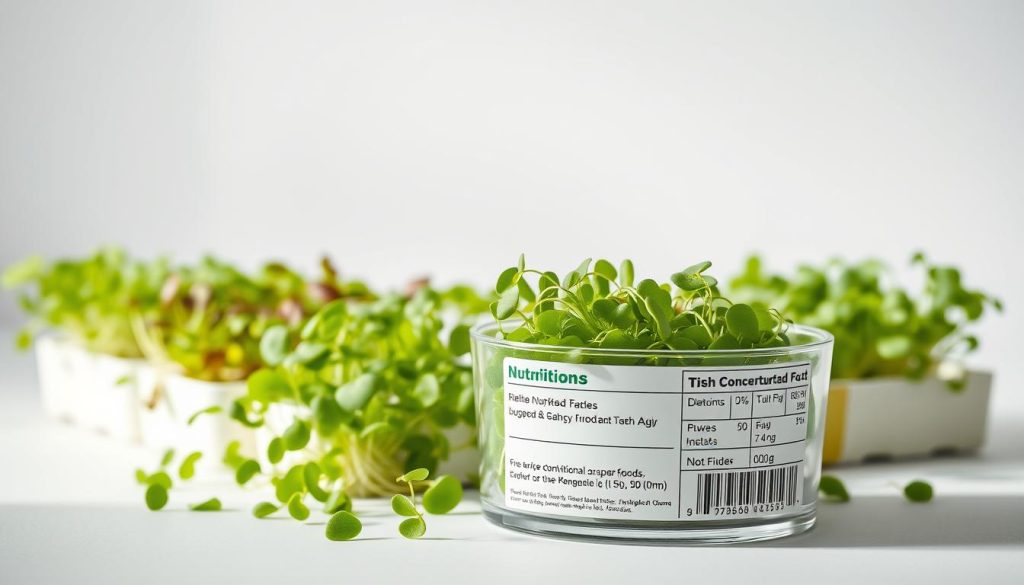Unlock the Power of Microgreens for Healthier Diets
Discover the nutritional powerhouse that’s changing healthy eating: microgreens. These tiny, vibrant greens are more than a trend. They are a food revolution packed with nutrients. Harvested in just 7-21 days, microgreens offer a big nutritional boost to your diet.
In the world of nutrient-dense foods, microgreens are a standout. Research shows they can have up to nine times more nutrients than mature veggies. This makes them a game-changer for those seeking optimal nutrition in a small package.
Microgreens support heart health and may lower the risk of chronic diseases. Their high vitamins, minerals, and antioxidants make them a great choice. They’re perfect for anyone wanting to increase their nutrition with little effort.
Key Takeaways
- Microgreens offer concentrated nutrients in tiny packages
- Harvested within 7-21 days of germination
- Potential to contain 9-40 times more nutrients than mature vegetables
- Support overall health and potential disease prevention
- Easy to incorporate into various diets
What Are Microgreens?
Microgreens are tiny, packed with nutrients and flavor. They are harvested when the first true leaves appear, usually 7-14 days after planting. Unlike sprouts, they grow in soil and are full of health benefits, making them superfoods.
These small plants come from many seed families, each with its own nutritional profile. The most popular include:
- Brassicaceae family (broccoli, radish, cabbage)
- Asteraceae family (sunflower, chicory)
- Apiaceae family (carrots, celery)
- Amaranthaceae family (beets, amaranth)
Nutritional Powerhouses
Microgreens are incredibly nutrient-rich, often having up to 40 times more nutrients than full-grown veggies. They are packed with vitamins, as research shows:
- Red cabbage microgreens: High in Vitamin C
- Cilantro microgreens: Rich in Vitamin A
- Garnet amaranth: Excellent source of Vitamin K
- Green daikon radish: Significant Vitamin E content
With over 100 varieties, microgreens are a great way to boost your diet. They grow fast and are small, ideal for city gardens and those looking to eat healthier.
The Role of Microgreens in a Balanced Diet
Microgreens are tiny greens that are packed with nutrients. They have up to 40 times more vitamins and minerals than regular plant leaves. Adding them to your diet can make your meals healthier and tastier.
Adding Variety to Your Meals
- Sprinkle microgreens on sandwiches for an instant nutrient boost
- Blend into smoothies for enhanced nutritional value
- Use as a garnish for salads, soups, and main dishes
- Create colorful and flavorful wraps with microgreen fillings
Enhancing Flavor and Texture
Microgreens are not just healthy; they also add exciting flavors to your food. With their bright colors and unique tastes, they can turn simple dishes into gourmet meals. You can try different types like peppery radish or mild sunflower shoots.
Studies show that microgreens are very nutritious. For example, fenugreek microgreens can help cells take in sugar better by 25-44%. Red cabbage microgreens might also help lower body weight and cholesterol.
Whether you’re on a plant-based diet or just want to eat healthier, microgreens are a tasty and simple way to do it.
Health Benefits of Incorporating Microgreens
Microgreens are tiny green powerhouses full of health benefits. They are changing how we view nutrition. They offer a lot of vitamins and minerals in a small amount.
Studies show microgreens have up to 40 times more nutrients than full-grown veggies. This makes them a great choice for any diet.
Key Vitamins and Minerals
Microgreens are full of important nutrients. They have:
- High levels of Vitamin C for immune support
- Rich in Vitamin K for bone health
- Abundant in folate for cellular function
- Significant mineral content including iron and potassium
Antioxidant Properties
Microgreens are also packed with antioxidants. These tiny greens fight oxidative stress. This stress is linked to heart disease and cancer. Their high phenolic compounds protect cells from damage.
Supporting Immune Health
Eating microgreens boosts your immune system. They are full of nutrients that help your body fight off infections. This can lead to better overall health.
Microgreens are a simple way to improve your diet. They are easy to add to meals and offer many health benefits.
Microgreens for Weight Management
Looking for new ways to lose weight can be tough. But, microgreens are a tasty and healthy choice. They are packed with nutrients and make losing weight fun without losing flavor.

Microgreens are great for managing weight because they’re so nutritious. A cup of them has only 5 to 30 calories. This makes them perfect for anyone trying to eat healthy and lose weight.
Low-Calorie Nutrition Powerhouse
- Contains only 25-40 calories per 100g
- Packed with essential vitamins A, C, E, K
- High fiber content promotes feelings of fullness
- Supports metabolism and nutrient absorption
Nutrient-Dense Snacking Options
Smart snacking is key for weight loss, and microgreens are perfect for this. For example, red cabbage microgreens can help control weight gain and improve heart health. Purslane microgreens also have lots of omega-3 fatty acids, which can lower the risk of chronic diseases.
Adding microgreens to your meals can make your diet more interesting and healthy. They’re low in calories but full of nutrients. This makes them great for anyone trying to manage their weight.
How to Grow Your Own Microgreens
Gardening fans and health buffs can turn their homes into mini nutrition hubs by growing microgreens. These tiny greens are full of nutrients and easy to grow indoors. You don’t need much equipment or know-how.
Starting a microgreen garden is easy. With a few basic items, you can have a lively indoor garden. It will give you fresh, healthy greens in just 7-21 days.
Essential Indoor Growing Techniques
- Select shallow trays with drainage holes
- Use organic seed-starting mix or coconut coir
- Ensure consistent moisture without overwatering
- Provide adequate indirect sunlight or grow lights
- Maintain room temperature between 60-75°F
Best Microgreen Varieties for Beginners
- Broccoli: Quick-growing with exceptional nutrient density
- Radish: Spicy flavor and rapid germination
- Sunflower: Mild taste and robust growth
- Pea shoots: Sweet flavor and easy cultivation
- Arugula: Peppery taste with high vitamin content
Growing microgreens at home is great for sustainable living. It saves money on groceries and gives you fresh, organic greens. With a little time and effort, you can have a steady supply of nutritious greens from your windowsill.
Incorporating Microgreens into Your Meals
Microgreens are a great way to add nutrition and flavor to your meals. They are tiny but full of nutrients, having up to 40 times more than mature veggies.
Want to make your meals better? Microgreens are easy to add to many dishes. Here are some fun ways to use them:
Creative Recipe Ideas
- Sprinkle on salads for extra crunch and nutrition
- Blend into morning smoothies for a vitamin boost
- Use as a vibrant garnish for soups and main courses
- Create colorful sandwich toppings
- Mix into homemade pestos and sauces
Perfect Food Pairings
Microgreens go well with many foods. Try different types to find your favorite:
- Spicy radish microgreens with eggs
- Mild sunflower microgreens in grain bowls
- Peppery arugula microgreens with fish dishes
- Delicate basil microgreens in pasta
More adults are looking for plant-based options. Microgreens are a tasty and nutritious choice. They bring intense flavors and lots of nutrients to your meals.
Microgreens for Vegetarian and Vegan Diets
Plant-based diets are becoming more popular. Microgreens are a great way for vegetarians and vegans to get more nutrients. These small greens are full of important vitamins and minerals.
Microgreens are great for vegetarians and vegans. They offer nutrients that can be hard to find in plant-based foods.
Plant-Based Protein Sources
Some microgreens are high in protein, which is key for vegetarians. Chickpea microgreens, for example, have 18.96% to 28.69% protein. This makes them a great addition to a healthy diet.
- Amaranth microgreens offer substantial protein content
- Essential amino acids support comprehensive protein intake
- High fiber content aids digestive health
Easy Substitutions
Adding microgreens to your meals is easy. They can replace other ingredients, adding flavor and nutrition.
- Use microgreens as salad base replacements
- Blend into smoothies for added nutrition
- Garnish soups and main dishes
Microgreens are a powerful tool for those on plant-based diets. They help ensure you get all the vitamins, minerals, and proteins you need.
Addressing Common Myths About Microgreens
Microgreens are known for being packed with nutrients, but many myths still exist. It’s important to know the truth to make better food choices.

Many are curious about the health perks of these small greens. Research has uncovered some interesting facts that debunk common myths:
Nutritional Misconceptions Debunked
- Not all microgreens have the same nutritional value
- Some microgreens have up to 40 times more nutrients than full-grown veggies
- The nutritional content varies a lot between different microgreen types
Safety and Consumption Guidelines
Eating microgreens is usually safe if you follow some simple rules. Here are the key safety tips:
- Get microgreens from trusted suppliers
- Wash them well before eating
- Keep them in a clean fridge
- Eat them within a few days of picking
A study looked at 17 types of microgreens and found they all have unique nutrients. For example, scallion, red cabbage, amaranth, and Genovese basil are great for calcium. Sunflower microgreens are especially rich in zinc and copper.
Even though microgreens are super healthy, they shouldn’t be the only thing you eat. They’re great for adding extra vitamins and minerals to your meals because they’re so nutrient-dense.
Sustainability of Microgreens
Microgreens are a key part of sustainable living and urban gardening. They are small but pack a big nutritional punch. This makes them a great choice for local food production.
The benefits of microgreens for the environment are huge. They need very little water and can grow in small spaces:
- Extremely low water consumption
- Can be grown in small urban spaces
- Minimal pesticide requirements
- Rapid growth cycle (7-21 days)
Ecological Advantages of Microgreen Cultivation
Growing microgreens can greatly reduce your carbon footprint. These greens are full of nutrients and have almost no waste. They can be grown vertically all year, with little harm to the environment.
Supporting Local Agriculture
Microgreens are vital for local food systems. Most farms that grow them deliver within 20 miles. This cuts down on emissions and supports local farming.
By choosing microgreens, we help make our food system more sustainable. It focuses on local production, cuts down on environmental harm, and helps communities stay healthy.
Tips for Choosing the Right Microgreens
Exploring microgreens means knowing their special traits and health benefits. They are key to a healthy diet, offering a big nutritional boost. Some microgreens have up to 40 times more nutrients than regular veggies.
When buying microgreens, choose from local farmers’ markets, specialty stores, or online. Look for leaves that are bright and fresh. Soil-grown microgreens are often more nutritious than those grown in water.
Microgreens come in different tastes and health perks. Radish greens are spicy, while pea shoots are sweet. Try sunflower greens for iron or broccoli for a broccoli-like nutrition punch. Mixing up your greens can make meals more exciting and nutritious.
To keep microgreens fresh, store them in a sealed container with a paper towel. Adding just 1-2 tablespoons to your food can greatly improve your diet’s healthiness.